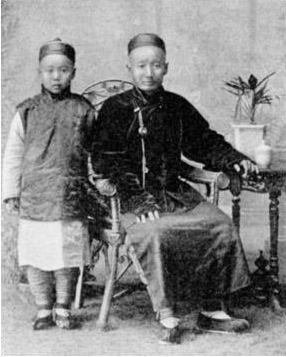Kaifeng Jews
Kaifeng Jews are members of a small Jewish community in Kaifeng, in the Henan province of China, whose members have assimilated into Chinese society while preserving some Jewish traditions and customs. Their history dates back to the Northern Song Dynasty (960–1127), when Kaifeng was the capital of China and a major commercial center. It is believed that Jewish merchants from Persia or India settled in Kaifeng during this period, forming a community that was recognized by the imperial government.
History[edit | edit source]
The earliest evidence of the Jewish community in Kaifeng comes from a stele erected in 1489, which recounts the history of the Jews in China and mentions the construction of a synagogue in 1163. The community thrived for several centuries, enjoying the patronage of the Chinese emperors and engaging in trade and other professions. Over time, the Kaifeng Jews began to adopt Chinese customs and language, gradually becoming more assimilated into Chinese society. Despite this assimilation, they continued to practice certain Jewish rituals and maintained a distinct identity.
By the Ming Dynasty (1368–1644), the Kaifeng Jewish community had become well-established, with its members taking on Chinese names while still keeping their Jewish faith. However, the community began to decline in the late Ming and early Qing Dynasty (1644–1912) periods due to isolation from other Jewish communities, intermarriage with the local Chinese population, and the loss of contact with Jewish practices and Hebrew language.
Religious Practices and Assimilation[edit | edit source]
The religious practices of the Kaifeng Jews were a blend of Jewish and Chinese traditions. They observed Jewish holidays, such as Passover and Yom Kippur, and followed dietary laws that were adapted to Chinese cuisine. The synagogue in Kaifeng, which was rebuilt several times, followed traditional Chinese architecture, demonstrating the integration of Jewish and Chinese cultures.
Over the centuries, the Kaifeng Jews became increasingly assimilated into Chinese society. By the 19th century, the community had largely lost its distinct Jewish practices, and the synagogue fell into disrepair and was eventually destroyed by floods in the 1850s. Today, only a few families in Kaifeng claim Jewish ancestry, and knowledge of Jewish traditions has largely been lost.
Revival of Jewish Identity[edit | edit source]
In recent years, there has been a renewed interest in the Jewish heritage of the Kaifeng community. Some descendants have begun to explore their Jewish roots, studying Jewish religion and culture. Efforts have also been made to reconnect the Kaifeng Jews with the global Jewish community, including invitations to Israel and support from Jewish organizations.
Cultural Significance[edit | edit source]
The history of the Kaifeng Jews is a unique example of cultural and religious integration and assimilation. It highlights the fluidity of identity and the ways in which religious and ethnic communities can merge over time. The story of the Kaifeng Jews also contributes to our understanding of the Jewish diaspora and the diverse experiences of Jewish communities around the world.
See Also[edit | edit source]
Search WikiMD
Ad.Tired of being Overweight? Try W8MD's physician weight loss program.
Semaglutide (Ozempic / Wegovy and Tirzepatide (Mounjaro / Zepbound) available.
Advertise on WikiMD
|
WikiMD's Wellness Encyclopedia |
| Let Food Be Thy Medicine Medicine Thy Food - Hippocrates |
Translate this page: - East Asian
中文,
日本,
한국어,
South Asian
हिन्दी,
தமிழ்,
తెలుగు,
Urdu,
ಕನ್ನಡ,
Southeast Asian
Indonesian,
Vietnamese,
Thai,
မြန်မာဘာသာ,
বাংলা
European
español,
Deutsch,
français,
Greek,
português do Brasil,
polski,
română,
русский,
Nederlands,
norsk,
svenska,
suomi,
Italian
Middle Eastern & African
عربى,
Turkish,
Persian,
Hebrew,
Afrikaans,
isiZulu,
Kiswahili,
Other
Bulgarian,
Hungarian,
Czech,
Swedish,
മലയാളം,
मराठी,
ਪੰਜਾਬੀ,
ગુજરાતી,
Portuguese,
Ukrainian
Medical Disclaimer: WikiMD is not a substitute for professional medical advice. The information on WikiMD is provided as an information resource only, may be incorrect, outdated or misleading, and is not to be used or relied on for any diagnostic or treatment purposes. Please consult your health care provider before making any healthcare decisions or for guidance about a specific medical condition. WikiMD expressly disclaims responsibility, and shall have no liability, for any damages, loss, injury, or liability whatsoever suffered as a result of your reliance on the information contained in this site. By visiting this site you agree to the foregoing terms and conditions, which may from time to time be changed or supplemented by WikiMD. If you do not agree to the foregoing terms and conditions, you should not enter or use this site. See full disclaimer.
Credits:Most images are courtesy of Wikimedia commons, and templates, categories Wikipedia, licensed under CC BY SA or similar.
Contributors: Prab R. Tumpati, MD





